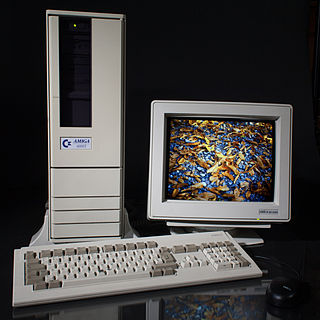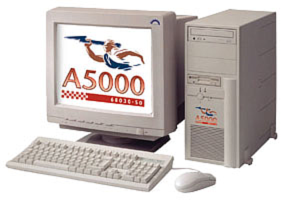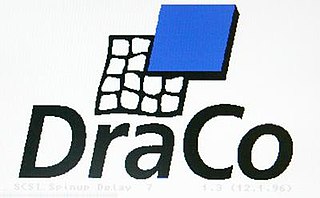This is a list of models and clones of Amiga computers.
The first Amiga computer was the "Lorraine" by Amiga Corporation in 1984, developed using the Sage IV system. [1] It consisted of a stack of breadboarded circuit boards. Commodore International purchased the company and the prototype and released the first model, Amiga 1000 in 1985.
| Amiga Production Timeline | ||||||||||||||||||||||||||||||||||||||||||||||||||||||
|---|---|---|---|---|---|---|---|---|---|---|---|---|---|---|---|---|---|---|---|---|---|---|---|---|---|---|---|---|---|---|---|---|---|---|---|---|---|---|---|---|---|---|---|---|---|---|---|---|---|---|---|---|---|---|
| 1985 | 1986 | 1987 | 1988 | 1989 | 1990 | 1991 | 1992 | 1993 | 1994 | 1995 | 1996 | 1997 | 1998 | |||||||||||||||||||||||||||||||||||||||||
| 3 | 4 | 1 | 2 | 3 | 4 | 1 | 2 | 3 | 4 | 1 | 2 | 3 | 4 | 1 | 2 | 3 | 4 | 1 | 2 | 3 | 4 | 1 | 2 | 3 | 4 | 1 | 2 | 3 | 4 | 1 | 2 | 3 | 4 | 1 | 2 | 3 | 4 | 1 | 2 | 3 | 4 | 1 | 2 | 3 | 4 | 1 | 2 | 3 | 4 | 1 | 2 | |||
| Brand Owner | Commodore International | Escom | QuikPak | |||||||||||||||||||||||||||||||||||||||||||||||||||
| Chipsets | OCS | |||||||||||||||||||||||||||||||||||||||||||||||||||||
| ECS | ||||||||||||||||||||||||||||||||||||||||||||||||||||||
| AGA | ||||||||||||||||||||||||||||||||||||||||||||||||||||||
| Desktop | A1000 | A1500/A2000/A2500 | ||||||||||||||||||||||||||||||||||||||||||||||||||||
| A3000/A3000T/A3000UX | A4000/A4000T | |||||||||||||||||||||||||||||||||||||||||||||||||||||
| Low End | A500 | A500+ | A1200 | |||||||||||||||||||||||||||||||||||||||||||||||||||
| A600 | ||||||||||||||||||||||||||||||||||||||||||||||||||||||
| Game Console | CDTV | CD32 | ||||||||||||||||||||||||||||||||||||||||||||||||||||
| Model | Timescale | CPU type | RAM (base) | Bundled OS version | OS version supported | Additional information |
|---|---|---|---|---|---|---|
| Amiga 1000 | 1985–1987 | 68000 | 256 KB | 1.0 – 1.1 | 3.1 / 3.9 [note 1] / 3.2 [note 2] | Later A1000s shipped with 512 KB base memory |
| Amiga 2000 A-model | 1987 | 68000 | 1 MB | 1.2 | 3.9 / 3.2 | First desktop Amiga with internal expansion slots (Zorro II) used the Amiga 1000 chipset 512 KB Chip RAM, 512 KB Fast RAM on CPU slot card |
| Amiga 500 | 1987–1991 | 68000 | 512 KB | 1.2 – 1.3 | 3.1 / 3.2 | First "low-end" Amiga; later A500s shipped with 1 MB memory |
| Amiga 2000 | 1987–1992 | 68000 | 1 MB | 1.2 – 2.04 | 3.9 / 3.2 | revised expandable model with Amiga 500 chipset Hard-drive equipped versions were labeled "A2000HD" |
| Amiga 2500 | 1989–1990 | 68020, 68030 | 1 MB | 1.3 | 3.9 / 3.2 | A2000+68020/68030 card (not a distinct model) Hard-drive equipped versions were labeled "A2500HD" |
| Amiga 1500 | 1990–1991 | 68000 | 1 MB | 1.3 | 3.9 / 3.2 | UK only, variant of A2000 with two floppy drives and no HDD. This version originated with CBM UK Marketing who found it necessary to distinguish the floppy-only version from the A2000 with the general public. |
| Amiga CDTV | 1991–1992 | 68000 | 1 MB | 1.3 | 3.1 [2] / 3.2 | CD-ROM-based multimedia machine |
| Model | Timescale | CPU type | RAM (base) | Bundled OS version | OS version supported | Additional information |
|---|---|---|---|---|---|---|
| Amiga 3000 | 1990–1992 | 68030 | 1 MB Chip 1-4 MB Fast | 1.3 – 2.04 | 3.9 / 4.1 FE [note 3] / 3.2 | First Zorro III system. Initial machines had a 1.4 beta ROM that looked for a "super" Kickstart disk similar to the 1000. It could load Kickstart versions 1.3, 2.0, and 2.04 this way or from specially named partitions on the hard disk. Developers could also "kick" in higher versions of the OS, up to 3.1 |
| Amiga 3000T | 1991–1992 | 68030, 68040 | 1-2 MB Chip 1-4 MB Fast | 2.04 | 3.9 / 4.1 FE [note 3] / 3.2 | First "towerized" Amiga |
| Amiga 3000UX | 1990–199? | 68030 | 2 MB Chip 4 MB Fast | 1.3 – 2.04 | 3.9 / 4.1 FE [note 3] / 3.2 | UNIX-based Amiga 3000 |
| Amiga 500+ | 1991–1992 | 68000 | 1 MB | 2.04 | 3.1 / 3.2 | ECS-based A500 with 1 MB RAM base memory |
| Amiga 600 | 1992 | 68000 | 1 MB | 2.05 | 3.9 / 3.2 | First Amiga using SMT, built-in IDE and PCMCIA support. There was also an A600HD version that had a built-in hard disk. |
| Model | Timescale | CPU type | RAM (base) | Bundled OS version | OS version supported | Additional information |
|---|---|---|---|---|---|---|
| Amiga 4000 | 1992–1994 | 68EC030, 68040 | 2 MB Chip 2–4 MB Fast | 3.0 | 3.9 / 4.1 FE [note 3] / 3.2 | First AGA machine |
| Amiga 1200 | 1992–1996 | 68EC020 | 2 MB | 3.0 – 3.1 | 3.9 / 4.1 FE [note 3] / 3.2 | Entry-level AGA machine. Standard IDE controller and space for a 2.5" hard drive. A1200HD shipped with 20–209MB hard drives |
| Amiga CD32 | 1993–1994 | 68EC020 | 2 MB | 3.1 | 3.9 [note 1] / 3.2 | 32-bit CD-ROM-based console |
| Amiga 4000T | 1994–1996 | 68040, 68060 | 2 MB Chip 4 MB Fast | 3.1 | 3.9 / 4.1 FE [note 3] / 3.2 | Towerized version of the A4000 |
These models are not hardware compatible with the 68k Amigas.
| Model (motherboard) | Timescale | CPU type | RAM (base) | OS version | Additional information |
|---|---|---|---|---|---|
| AmigaOne SE (Teron CX) | 2002–2004 | PowerPC G3 | Varies | 4.0 – 4.1 FE | ATX format motherboard |
| AmigaOne XE (Teron PX) | 2003–2004 | PowerPC G3 or G4 | Varies | 4.0 – 4.1 FE | ATX format motherboard |
| MicroA1 – "C" and "I" (Teron Mini) | 2004–2005 | PowerPC G3 | 256 MB | 4.0 – 4.1 FE | Mini-ITX format motherboard |
| AmigaOne 500 | 2011–present | AMCC 460ex SoC | 2 GB | 4.1 – 4.1 FE | Complete system [3] |
| AmigaOne X1000 | 2012–2015 | PWRficient PA6T | 2 or 4+ GB | 4.1.5 – 4.1 FE | Complete system |
| AmigaOne X5000 | 2016–present | P5020 | 2 or 4+ GB | 4.1 FE | Complete system |
| Chipset | Introduction year | Resolution non-interlaced |
|---|---|---|
| Original Chip Set (OCS) | 1985 | 640 × 256 @ 4-bpp (PAL) |
| Enhanced Chip Set (ECS) | 1990 | 640 × 480 @ 2-bpp |
| Advanced Graphics Architecture (AGA) | 1992 | 640 × 480 @ 8-bpp |
These chipsets were planned but never fabricated.
| Chipset | Planned introduction year | Resolution non-interlaced | Comment |
|---|---|---|---|
| AAA chipset | 1992 | 1280 × 1024 @ 16-bpp | three "Nyx" technology demonstrators built |
| Amiga Ranger Chipset | 1988 | 1024 × 1024 @ 7-bpp | scratched in favor of ECS |
| AA+ Chipset | 1994 | 800 × 600 @ 8-bpp | improved AGA intended as low-end alternative to AAA |
| Hombre chipset | 1995 | 1280 × 1024 @ 32-bpp | integrating PA-RISC, never completed |
Some computers were released by other companies which were AmigaOS compatible.
Prototypes:
Due to management turmoil, some viable Amiga models under development were cancelled prior to release:
A number of new Amiga models were announced after the end of the Commodore model era. However, very few of them were ever produced beyond simple prototypes (if they even got that far). Some of these were announced by companies who later owned, or sought to own, the Amiga rights. Others were unofficial machines which would run AmigaOS, whilst others still were intended to run an operating system compatible with Amiga software. Some models that were never produced include:

Amiga is a family of personal computers produced by Commodore from 1985 until the company's bankruptcy in 1994, with production by others afterward. The original model is one of a number of mid-1980s computers with 16-bit or 16/32-bit processors, 256 KB or more of RAM, mouse-based GUIs, and significantly improved graphics and audio compared to previous 8-bit systems. These include the Atari ST—released earlier the same year—as well as the Macintosh and Acorn Archimedes. The Amiga differs from its contemporaries through custom hardware to accelerate graphics and sound, including sprites, a blitter, and four channels of sample-based audio. It runs a pre-emptive multitasking operating system called AmigaOS.

The Amiga 500, also known as the A500, was the first popular version of the Amiga home computer, "redefining the home computer market and making so-called luxury features such as multitasking and colour a standard long before Microsoft or Apple sold these to the masses." It contains the same Motorola 68000 as the Amiga 1000, as well as the same graphics and sound coprocessors, but is in a smaller case similar to that of the Commodore 128.

The Amiga 1000, also known as the A1000, is the first personal computer released by Commodore International in the Amiga line. It combines the 16/32-bit Motorola 68000 CPU which was powerful by 1985 standards with one of the most advanced graphics and sound systems in its class. It runs a preemptive multitasking operating system that fits into 256 KB of read-only memory and was shipped with 256 KB of RAM. The primary memory can be expanded internally with a manufacturer-supplied 256 KB module for a total of 512 KB of RAM. Using the external slot the primary memory can be expanded up to 8.5 MB.

The Motorola 68060 ("sixty-eight-oh-sixty") is a 32-bit microprocessor from Motorola released in April 1994. It is the successor to the Motorola 68040 and is the highest performing member of the 68000 series. Two derivatives were produced, the 68LC060 and the 68EC060.

The Amiga 600, also known as the A600, and full title Commodore Amiga 600, is a home computer introduced in March 1992. It is the final Amiga model based on the Motorola 68000 and the 1990 Amiga Enhanced Chip Set. A redesign of the Amiga 500 Plus, it adds the option of an internal hard disk drive and a PCMCIA port. Lacking a numeric keypad, the A600 is only slightly larger than an IBM PC keyboard, weighing approximately 6 pounds (2.72kg). It shipped with AmigaOS 2.0, which was considered more user-friendly than earlier versions of the operating system.

The Amiga 3000, or A3000, is a personal computer released by Commodore in June 1990. It is the successor to the Amiga 2000 and its upgraded model Amiga 2500 with more processing speed, improved graphics, and a new revision of the operating system.

The Amiga 2000 (A2000) is a personal computer released by Commodore in March 1987. It was introduced as a "big box" expandable variant of the Amiga 1000 but quickly redesigned to share most of its electronic components with the contemporary Amiga 500 for cost reduction. Expansion capabilities include two 3.5" drive bays and one 5.25" bay that could be used by a 5.25" floppy drive, a hard drive, or CD-ROM once they became available.

The Amiga 4000, or A4000, from Commodore is the successor of the Amiga 2000 and Amiga 3000 computers. There are two models: the A4000/040 released in October 1992 with a Motorola 68040 CPU, and the A4000/030 released in April 1993 with a Motorola 68EC030.

Pegasos was sold by Genesi USA, Inc., and designed by their research and design partner bplan GmbH based in Frankfurt, Germany. It is a MicroATX motherboard powered by a PowerPC 750CXe or PowerPC 7447 microprocessor, featuring three PCI slots, one AGP slot, two Ethernet ports, USB, DDR, AC'97 sound, and FireWire. Like the PowerPC Macintosh counterparts, it boots via Open Firmware.

The MOS Technology "Agnus", usually called Agnus, is an integrated circuit in the custom chipset of the Amiga computer. The Agnus, Denise and Paula chips collectively formed the OCS and ECS chipsets.
The Amiga is a family of home computers that were designed and sold by the Amiga Corporation from 1985 to 1994.

The Amiga 4000T, also known as A4000T, is a tower version of Commodore's A4000 personal computer. Using the AGA chipset, it was originally released in small quantities in 1994 with a 25 MHz Motorola 68040 CPU, and re-released in greater numbers by Escom in 1995, after Commodore's demise, along with a new variant which featured a 50 MHz Motorola 68060 CPU. Despite the subsequent demise of Escom, production was continued by QuikPak in North America into at least 1998.

The Amiga 1200, or A1200, is a personal computer in the Amiga computer family released by Commodore International, aimed at the home computer market. It was launched on October 21, 1992, at a base price of £399 in the United Kingdom and $599 in the United States.

The Power A5000 was a planned Amiga clone computer, announced by German DCE Computer Service GmbH and British Amiga peripherals manufacturer Power Computing Ltd.. It was one of the first Amiga clone computers announced after Gateway purchased the Amiga in 1997.

The Amiga Walker, sometimes incorrectly known as the Mind Walker, is a prototype of an Amiga computer developed and shown by Amiga Technologies, a subsidiary of Escom, in late 1995/early 1996. Walker was planned as a replacement for the A1200 with a faster CPU, better expansion capabilities, and a built-in CD-ROM. The Walker was never released; Escom and Amiga Technologies went bankrupt, and only two (three) prototypes were made.
The AA+ chipset was a planned Amiga-compatible chipset that Commodore International announced in 1992. There were two separate projects: the next generation Advanced Amiga Architecture chipset and the lower cost, more pragmatic AA+ chipset. The former was in development when Commodore declared bankruptcy; the latter existed only on paper. Both were cancelled when Commodore folded.
In addition to the Amiga chipsets, various specially designed chips have been used in Commodore Amiga computers that do not belong to the 'Amiga chipset' in a tight sense.

The Amiga CD32 (stylized as Amiga CD32) is a home video game console developed by Commodore as part of the Amiga line, as well as the final hardware to be developed by the company. Released in September 1993 in Europe, Australia, Canada, and Brazil, it was marketed as the "first" 32-bit games console and is essentially a keyboard-less Amiga 1200 personal computer without the I/O ports, but with the addition of a CD-ROM drive in place of floppy and a modified Advanced Graphics Architecture chipset for improved graphical performance.

The DraCo, also known as DraCo Vision in one of its later models, was a non-linear video editing workstation created by MacroSystem Computer GmbH in 1994, based on the Amiga platform.